Related Research Articles
The music of Turkey includes mainly Byzantine and Turkic elements as well as partial influences ranging from Greek traditional music, Ottoman music, Middle Eastern music and Balkan music, as well as references to more modern European and American popular music. Turkey is a country on the northeastern shore of the Mediterranean Sea, and is a crossroad of cultures from across Europe, North Africa, the Middle East, the Caucasus and South and Central Asia.

The Piano Sonata No. 11 in A major, K. 331 / 300i, by Wolfgang Amadeus Mozart is a piano sonata in three movements. Mozart likely composed the sonata while in Vienna or Salzburg by around 1783, although Paris and dates as far back as 1778 have also been suggested.
"Bey" is a Turkic title for a chieftain, and an honorific, traditionally applied to people with special lineages to the leaders or rulers of variously sized areas in the numerous Turkic kingdoms, emirates, sultanates and empires in Central Asia, South Asia, and The Middle East, such as the Ottomans, Timurids or the various khanates and emirates in Central Asia and the Eurasian Steppe. The feminine equivalent title was begum. The regions or provinces where "beys" ruled or which they administered were called beylik, roughly meaning "governorate" and/or "province". However the exact scope of power handed to the beks varied with each country, thus there was no clear-cut system, rigidly applied to all countries defining all the possible power and prestige that came along with the title.
Turkish music, in the sense described here, is not the music of Turkey, but rather a musical style that was occasionally used by the European composers of the Classical music era. This music was modelled—though often only distantly—on the music of Turkish military bands, specifically the Janissary bands.

Ottoman music was developed in Istanbul and other major Ottoman cities and towns through the palaces and Sufi lodges of the Ottoman Empire. Above all a vocal music, Ottoman music traditionally accompanies a solo singer with a small instrumental ensemble. In recent times, instruments might include turkish tanbur (lute), ney, klasik kemençe, keman, kanun (zither), or other instruments. Sometimes described as monophonic music, the variety of ornamentation and variation in the ensemble requires the more accurate term heterophonic.
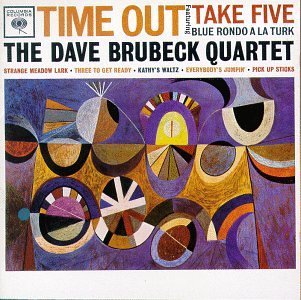
Time Out is a studio album by the American jazz group the Dave Brubeck Quartet, released in 1959 on Columbia Records. Recorded at Columbia's 30th Street Studio in New York City, it is based upon the use of time signatures that were unusual for jazz such as 9
8, 6
4 and 5
4. The album is a subtle blend of cool and West Coast jazz.

Mehmet Munir Ertegun was a Turkish legal counsel in international law to the "Sublime Porte" of the late Ottoman Empire and a diplomat of the Republic of Turkey during its early years. Ertegun married Emine Hayrünnisa Rüstem in 1917 and the couple had three children, two of whom were Nesuhi and Ahmet Ertegun, the brothers who founded Atlantic Records and became iconic figures in the American music industry.
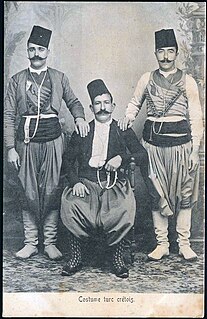
The Cretan Turks, Muslim-Cretans or Cretan Muslims were the Muslim inhabitants of the Greek island of Crete and now their descendants, who settled principally in Turkey, the Dodecanese Islands under Italian administration, Syria, Lebanon, Israel, Libya, and Egypt, as well as in the larger Turkish diaspora.
"Blue Rondo à la Turk" is a jazz standard composition by Dave Brubeck. It appeared on the album Time Out in 1959. It is written in 9
8 time, with one side theme in 4
4, and the choice of rhythm was inspired by the Turkish aksak time signatures. It was originally recorded by the Dave Brubeck Quartet with Dave Brubeck on piano, Paul Desmond on alto saxophone, Eugene Wright on bass, and Joe Morello on drums.

The State Opera and Ballet is the national directorate of opera and ballet companies of Turkey, with venues in Ankara, İstanbul, İzmir, Mersin, Antalya and Samsun. The directorate is bound to the Ministry of Culture and Tourism. As of January 2018, Murat Karahan is the General Director.
The Turks in Hungary, also referred to as Hungarian Turks, refers to ethnic Turks living in Hungary. The Turkish people first began to migrate predominately from Anatolia during the Ottoman rule of Hungary (1541-1699). A second wave of Ottoman-Turkish migration occurred in the late 19th century when relations between the Ottoman Empire and the Austro-Hungarian Empire improved; most of these immigrants settled in Budapest. Moreover, there has also been a recent migration of Turks from the Republic of Turkey, as well as other post-Ottoman states.

Fatma Aliye Topuz, often known simply as Fatma Aliye or Fatma Aliye Hanım, was a Turkish novelist, columnist, essayist, women's rights activist and humanitarian. Although there was an earlier published novel by the Turkish female author Zafer Hanım in 1877, since that one remained her only novel, Fatma Aliye Hanım with her five novels is credited by literary circles as the first female novelist in Turkish literature and the Islamic world.
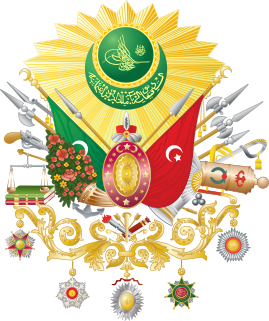
The following outline is provided as an overview of and topical guide to the Ottoman Empire:
The Ottoman Empire (1299–1922) is a historical Muslim empire, also known by its contemporaries as the Turkish Empire or Turkey after the principal ethnic group. At its zenith in the second half of the 16th century it controlled Southeast Europe, Southwest Asia and North Africa. Below are the links to articles about the Ottoman Empire.
The Pera Ensemble is a Turkish early music group specializing in music of the Ottoman Empire. The group was founded by oud player Mehmet Cemal Yeşilçay and psaltery player Mehmet İhsan Özer. The name "Pera" comes from the old Greek name of the cosmopolitan Beyoğlu district on the European side of İstanbul, Turkey. The instrumental ensemble includes oud, qanun, kemençe, and European medieval and baroque instruments: viola d'amore, viola da gamba, theorbo, shawm, and percussion.
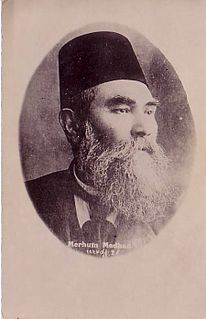
Ahmet Mithat was an Ottoman journalist, author, translator and publisher during the Tanzimat period. In his works, he was known as Ahmet Mithat Efendi, to distinguish him from the contemporary politician Midhat Pasha. Ahmet Mithat Efendi took his name from Ahmed Şefik Midhat Pasha, as he worked for a time as an official and newspaper editor in Midhat Pasha's Vilayet of the Danube.
Bîmen Şen was a Turkish composer and lyricist of Armenian descent. He was born in 1873 and died in Istanbul, Turkey on 26 August 1943.

The TGC Press Media Museum, aka Istanbul Press Media Museum, is a history and technology museum dedicated to mass communication in Turkey featuring exhibitions about journalism. It is located in the Çemberlitaş neighborhood of Fatih district in İstanbul, Turkey. Established in 1988, it is owned and operated by the Journalists Association of Turkey.
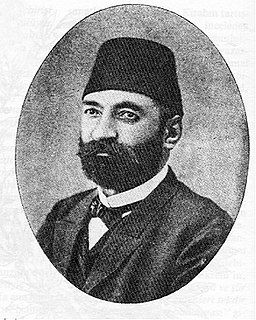
Muallim Naci, literally "Naci The Teacher", was an Ottoman writer, poet, educator and literary critic.
References
- 1 2 3 4 Eric Ederer, The Cümbüş as Instrument of “the Other” in Modern Turkey
- ↑ "Alla franca versus alla turca". Hürriyet Daily News. Retrieved 2019-05-18.
- ↑ Cardiff University School of Music, Meet our PhD supervisors: Dr John Morgan O'Connell
- ↑ Hedrick Smith. "Rediscovering Dave Brubeck". PBS.
- ↑ University of Illinois Press, Ethnomusicology, Vol. 49, No. 2 (Spring/Summer, 2005), pp. 177–205, John Morgan O'Connell, In the Time of Alaturka: Identifying Difference in Musical Discourse.
- ↑ Hedrick Smith. "Rediscovering Dave Brubeck". PBS.
- ↑ Mithat, Ahmet (2016). Felâtun Bey and Râkım Efendi: An Ottoman Novel. Syracuse University Press. p. 3. ISBN 0815610645.